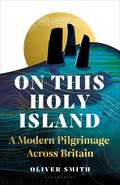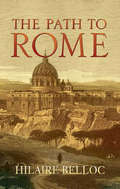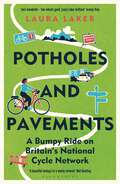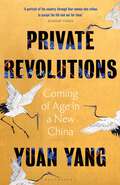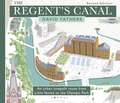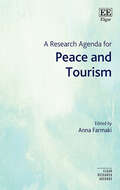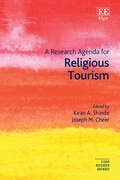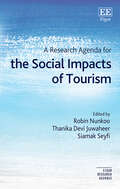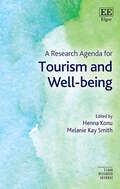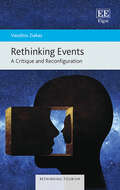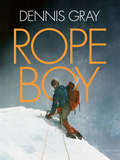- Table View
- List View
On This Holy Island: A Modern Pilgrimage Across Britain
by Oliver SmithAcclaimed travel writer Oliver Smith sets out to radically reframe our idea of 'pilgrimage' in Britain by retracing sacred travel made across time, from murmurs of ritual journeys in the depths of Ice Age to new pilgrimages of the 21st century. He embarks on an epic adventure across sacred British landscapes – climbing into remote sea caves, sleeping inside Neolithic tombs, scaling forgotten holy mountains and once marooning himself at sea. Following holy roads to churches, cathedrals and standing stones, this evocative and enlightening travelogue explores places prehistoric, pagan and Christian, but also reveals how football stadiums and music festivals have become contemporary places of pilgrimage. The routes walked are often ancient, the pilgrims he meets are always modern. But underpinning the book is a timeless truth: that making journeys has always been a way of making meaning. So often, Oliver finds, “the unravelling of a path goes in tandem with the unravelling of the soul.”
Passenger ship (Large Print)
This large passenger ship is shown from the side. There is a locator dot shown, which will be at the top left of the page when the image is the right way up. The front (bow) of the ship is on the left of the page, and the rear (stern) of the ship is on the right of the page. Along the bottom of the ship is the hull which has a row of porthole windows. Above the hull are the upper decks. There are two more rows of portholes, one for each deck. In the top left corner of the upper decks there is a window for the captain. Along the very top of the ship, there is a tall radio mast and to the right of this a big funnel with smoke coming out of the top.
Passenger ship (UEB Contracted)
This large passenger ship is shown from the side. There is a locator dot shown, which will be at the top left of the page when the image is the right way up. The front (bow) of the ship is on the left of the page, and the rear (stern) of the ship is on the right of the page. Along the bottom of the ship is the hull which has a row of porthole windows. Above the hull are the upper decks. There are two more rows of portholes, one for each deck. In the top left corner of the upper decks there is a window for the captain. Along the very top of the ship, there is a tall radio mast and to the right of this a big funnel with smoke coming out of the top.
Passenger ship (UEB uncontracted)
This large passenger ship is shown from the side. There is a locator dot shown, which will be at the top left of the page when the image is the right way up. The front (bow) of the ship is on the left of the page, and the rear (stern) of the ship is on the right of the page. Along the bottom of the ship is the hull which has a row of porthole windows. Above the hull are the upper decks. There are two more rows of portholes, one for each deck. In the top left corner of the upper decks there is a window for the captain. Along the very top of the ship, there is a tall radio mast and to the right of this a big funnel with smoke coming out of the top.
The Path to Rome
by Hilaire BellocHilaire Belloc's best work — according to the author, as well as most critics — The Path to Rome is less concerned with Rome itself than with a pilgrim's journey to the Eternal City. A spirited Catholic apologist, Belloc traveled on foot from Toul (near Nancy), France, and crossed the Alps and the Apennines in order to, in his words, "see all Europe which the Christian Faith has saved." Afterward, he turned his pen from his usual polemics to literature, and related in finely crafted prose his myriad experiences with the people he met along the way, as well as his reflections on tradition, politics, landscape, and much else. Throughout, the work abounds in Belloc's inimitable wit and good humor, and displays his profound love for the land, his faith, and his fellow man.
Potholes and Pavements: A Bumpy Ride on Britain’s National Cycle Network
by Laura Laker'Just wonderful – two wheels good, Laura Laker brilliant. Part travel diary, part love poem to Britain's cycle network ... it's difficult not to be inspired by this fabulous book.' Jeremy Vine 'With a passion for both cycling and words, there are few more qualified to paint a picture of the NCN's potential than Laura Laker.' Chris BoardmanA unique journey around the UK's National Cycle Network and one journalist's quest to investigate the state of our country's cycling.What if we were less reliant on our cars? What if there were safe cycling paths to take us places instead? What if those paths led to the next town, the next village and the countryside beyond? This was the dream of a group of Bristolian idealists in the 1970s when they founded Britain's National Cycle Network, which now runs to nearly 13,000 miles across the country. Journalist Laura Laker sets off on an odyssey around the UK to see where the NCN began, and where it is now. What has gone right – and wrong – with this piece of national infrastructure? Why is it run by a charity whose CEO once admitted 'we've had enough of it being crap, we need to fix it'? Laura lifts the lid on this maddening, patchy, and at times dangerous network, and the similarly precarious politics and financing that make it what it is.She discovers beauty, friendship and adventure along the way, from the Cairngorms to Cornwall, from the Pennines to the South Wales coast. On her mission to pin down what the NCN is and what it means to those who use it, she also meets up with high-profile travelling companions, including Chris Boardman and Ned Boulting. In a country where 71% of trips are less than five miles, two thirds of Britons say they want to cycle more and doing so could help our climate, health and wellbeing. Laura is on a mission to see if we can make that dream a reality.
Private Revolutions: Coming of Age in a New China
by Yuan Yang'As powerfully intimate as it is politically incendiary' VOGUE'Private Revolutions could be a Netflix series, for family, violence and romance abound' IRISH TIMES 'A portrait of China through four women who refused to accept the life laid out for them. Incredible' SUNDAY TIMES 'A revelatory, moving and tender tale of hopes, fears and change' PETER FRANKOPAN*A Sunday Times, Observer & BBC Highlight for 2024*This is a book about the coming of age of four women born in China in the 1980s and 1990s, in a society about to change beyond recognition.It is about Leiya, who wants to escape the fate of the women in her village. Still underage, she bluffs her way on to the factory floor. It is about June, who at fifteen sets what her family thinks is an impossible goal: to attend university rather than raise pigs. It is about Siyue, ranked second-to-bottom of her English class, who decides to prove her teachers wrong. And it is about Sam, who becomes convinced that the only way to change her country is to become an activist – even as the authorities slowly take her peers from the streets. With unprecedented access to the lives, hopes, homes, dreams and diaries of four ordinary women over a period of six years, Private Revolutions gives a voice to those whose stories go untold. At a time of rising state censorship and suppression, it unearths the identity of modern Chinese society – and, through the telling, something of our own.
The Regent's Canal Second Edition: An urban towpath route from Little Venice to the Olympic Park
by David FathersThe Regent's Canal, the Limehouse Cut, the Hertford Union and the Lee Navigation collectively cut a swathe through north and east London. This 14-mile path, cycle and waterway is a journey full of intriguing contrasts:- From the amateur sports fields of Regent's Park to London's new Olympic Park.- From the studio where Hitchcock directed some of his early films to MTV in Camden Lock.- From fine period housing to industrial wasteland, social housing and new canalside builds.- From the pleasure boats chugging to Camden to the sleek Eurostars roaring off to Paris.The use of canals has changed dramatically over the past fifty years from one of industrial transportation to waterfront living and leisure activities. The canals in this book have undergone major phases of rebirth with new developments at King's Cross, Limehouse and the Queen Elizabeth Olympic Park in Newham.Illustrator and writer David Fathers offers a snapshot of how the canals were formed and how they appear today, in a series of arresting and information-packed pages following a course from Little Venice to the River Thames at Limehouse, and on to the Olympic Park.
A Research Agenda for Peace and Tourism (Elgar Research Agendas)
Elgar Research Agendas outline the future of research in a given area. Leading scholars are given the space to explore their subject in provocative ways, and map out the potential directions of travel. They are relevant but also visionary.This highly prescient Research Agenda critically examines the delicate intersection of peace and tourism and proposes further research in order to explore how tourism may contribute to peace or, conversely, hinder the peacebuilding efforts of destinations in conflict.Anna Farmaki brings together a wealth of expertise from scholars who present the peace and tourism nexus from a variety of different perspectives, using both empirical evidence and conceptual research to support cases. Chapters discuss tourism as a peace-builder, the acceptance of dark tourism, a gender approach to peace through tourism, and corporate social responsibility as a contributor to peace in conflict-ridden situations. This innovative and forward-thinking Research Agenda provides a vital contribution to this burgeoning area of research, carrying implications for local communities, tourist destinations and wider society at large in conjunction with the UN’s 2030 Sustainable Development Agenda.Providing a much-needed re-examination of the connection between peace and tourism, this book will prove essential reading for students, academics and researchers interested in human geography, political geography and geopolitics, tourism management and business and management. Considering many practical outcomes of tourism policy, this book will also benefit professionals working in tourism, foreign policy, public policy and international relations.
A Research Agenda for Religious Tourism (Elgar Research Agendas)
Elgar Research Agendas outline the future of research in a given area. Leading scholars are given the space to explore their subject in provocative ways, and map out the potential directions of travel. They are relevant but also visionary.Incisive and interdisciplinary, this Research Agenda broaches topics that have been under-researched within religious tourism, including: place attachment and marketing; memory and modification of sacred landscapes for tourism needs; the darker sides of religious tourism; multi-stakeholder governance; mission-trips; and allied forms of tourism.With contributions from top scholars, the book includes cases from across Europe and Asia, exploring pilgrimage sacred landscapes for different religions. Building on emerging themes including the importance of governance, conflicts associated with pilgrimage and religious tourism, gender and gendered dimensions, resilience in the wake of the recent pandemic, and newer ways of performing religious tourism such as virtual reality, it sets a research agenda for future inquiry.This thought-provoking Research Agenda will be a valuable resource for scholars of tourism, human geography, heritage studies, anthropology, and religious studies.
A Research Agenda for the Social Impacts of Tourism (Elgar Research Agendas)
Elgar Research Agendas outline the future of research in a given area. Leading scholars are given the space to explore their subject in provocative ways, and map out the potential directions of travel. They are relevant but also visionary.This timely Research Agenda explores the crucial need to understand the social impact of tourism in order to manage industry growth sustainably. Highlighting the multifaceted nature of tourism, chapters uncover the intricate relationships between tourists and host communities and investigate this complex social fabric. Bringing together a diverse array of international perspectives and research approaches, it covers governance for sustainable tourism, resident attitudes towards tourism, the impact of local lodging on residents’ perceptions of tourism, and the social implications of COVID-19. Using an interdisciplinary lens, this Research Agenda advocates for the need to move beyond a positivist paradigm and to adapt current tourism strategy in order to create effective sustainable tourism practices. Contributors propose a new approach which emphasizes the significance of theoretical and methodological foundations in studying social impacts, aiming to capture the tourist and host community nexus in all its complexity and depth.This Research Agenda will be an essential resource for students, academics, and researchers specializing in tourism, urban planning, human geography, and sociology. It will also prove insightful for industry practitioners and policymakers seeking a comprehensive understanding of the social dynamics and implications of tourism, as well as those interested in addressing and mitigating the negative impacts of tourism.
A Research Agenda for Tourism and Wellbeing (Elgar Research Agendas)
Elgar Research Agendas outline the future of research in a given area. Leading scholars are given the space to explore their subject in provocative ways, and map out the potential directions of travel. They are relevant but also visionary.Interdisciplinary and multidimensional in its approach, this insightful Research Agenda critically analyses the principal issues that have emerged in recent years from tourism and wellbeing studies. It provides a detailed analysis of definitions and key concepts and explores the research agenda related to product and service development, motivation, segmentation and management using established as well as experimental methodologies.Enlightening contributions from leading scholars detail the role, indicators, and measurement of wellbeing in tourism economics, expertly examining issues of individual wellbeing and how experiences of wellbeing can be facilitated for both employees and tourists. The various impacts of tourism on wellbeing are analysed from a diverse range of perspectives, including collective experiences of social and diasporic tourism and individual experiences of wellbeing and transformation.Succinct and cutting-edge, A Research Agenda for Tourism and Wellbeing will appeal to students, academics, and researchers in tourism, sociology, economics, business, psychology, and human geography. It will also prove insightful to practitioners involved in product and service development, tourism and destination, marketing and human resources management sectors.
Rethinking Events: A Critique and Reconfiguration (Rethinking Tourism series)
by Vassilios ZiakasThis invigorating read explores the inherent unsustainability of events, exacerbated by the COVID-19 pandemic crisis. Vassilios Ziakas challenges the dominant paradigms of the field, suggesting the need to seriously rethink how we view, study and manage events in order to develop holistic event management frameworks which foster their adaptability and resilience.Treating events as complex ecosystems, Ziakas constructs a transdisciplinary explanatory framework to provide an integrative outlook for treating events and develop a comprehensive analytic for their study. Merging the contextual, policy, operational and sociocultural grounds of event portfolios, the book sheds light on how events operate as social systems interlinked with community networks. Chapters introduce cross-management as a holistic approach enabling inter-industry operational practices to move away from the current fragmented outlook across events theory and practice.Incisive and visionary, this book will be a thought-provoking read for students, researchers and practitioners in event management, tourism, leisure studies, sport management and cultural studies.
Rethinking Tourism and Development (Rethinking Tourism series)
by Richard Sharpley David J. TelferRethinking Tourism and Development provides a critical analysis of the tourism industry's impact on development and the environment. While tourism contributes significantly to the global economy, it also generates environmental costs that can no longer be ignored. This book challenges the conventional paradigm of sustainable tourism development and proposes a radical new approach to address the negative impacts of tourism.Chapters cover the global environmental crisis, the overconsumption of tourism and the impact of a growth-based economy in relation to tourism and development. Through a detailed examination of the tourism industry's adherence to the pursuit of economic growth, Richard Sharpley and David J. Telfer argue that the expansion of tourism has resulted in exploitation and inequality. It explores the concept of degrowth and proposes that tourism should be rethought within this framework, offering a possible pathway to a post-growth world.The book is ideal for undergraduate and postgraduate tourism students, particularly those focusing on sustainability and tourism economics. It will also be an interesting read for human geography, development studies and environment scholars and academics looking for new insights into the relationship between tourism and development, and how it could be reframed.
The Romance of the Colorado River
by Frederick S. DellenbaughIn 1871, seventeen-year-old Fred Dellenbaugh walked into a hotel room in Chicago, and with a “You’ll do, Fred,” began a lifetime of danger-fraught exploration. Under the lead of John Wesley Powell, a Civil War hero with only one arm, Fred journeyed into the Grand Canyon and its subsidiary canyons and rivers, with the intention of exploring, mapping, and recording description of the uncharted territory. The men found themselves battling the great force of the Colorado River, with its fatal, quick rapids and mighty waterfalls. Their small, frail boats were no match for the river, and as they began to capsize and as supplies were lost overboard, the expedition quickly became about survival. It was only through the steady command of Major Powell that the team prevailed. They went on to accomplish their mission, which has become historically significant today. <P><P> The Romance of the Colorado River is Dellenbaugh’s personal story, written thirty years after the great adventure. The volume includes twenty of the author’s original illustrations, as well as nearly 150 contemporary photographs, which provide an accurate image of what the explorers encountered during their expedition. Dellenbaugh also recounts previous attempts to explore the valley, by both Europeans and fellow Americans, adding a historical element to the story. Part adventure narrative and part geography survey of the Colorado River, this book offers a unique firsthand account of a fascinating scientific expedition.
Rope Boy: A life of climbing from Yorkshire to Yosemite
by Dennis GrayRope Boy is the story of Dennis Gray, a young lad from Leeds who gets his first taste of rock at age eleven, and goes on to become a prominent figure in the UK climbing scene for decades to come.Gray’s climbing career began with the ‘Bradford Lads’, climbing in Yorkshire, Scotland and Wales, exploring classic crags such as Clogwyn Du’r Arddu, tentatively venturing into an exciting new game, and inspired by the pioneering Arthur Dolphin. Just as the scene was rapidly developing in the 1950s, so was Gray’s desire to climb, and he was soon climbing with the Rock and Ice legends Joe Brown, Don Whillans and Nat Allen, among others, making first ascents such as North Crag Eliminate on Castle Rock in the Lake District and Grond on Dinas Cromlech in Wales.Larger objectives beckoned, and Gray embarked upon multiple expeditions to the Alps as well as to the Himalaya, the Andes, and America, making numerous first ascents along the way including the north ridge of Alpamayo in Peru’s Cordillera Blanca, and Mukar Beh in the Kulu valley of India.Rope Boy relays times of frustration, adventure and success, and the hilarious and dauntless friends with whom Gray shared his experiences. Dennis Gray’s transformation from rope boy to expedition leader is an inspiring and encouraging tale of one boy’s journey into adulthood via a world of rock, snow and ice.

